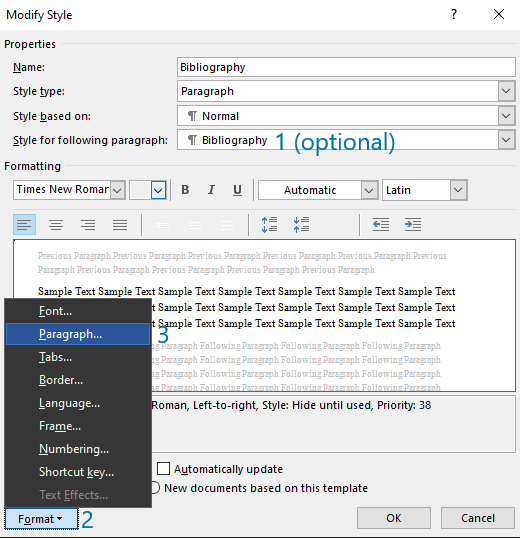The process of formatting bibliographies has several elements.1 If you’re using SBL style, these elements include
- the structure and formatting of each bibliography entry considered just itself. For these components, Zotero proves incredibly helpful since it allows you to insert a bibliography with the push of a button from the word processor plugin.2
- your bibliography’s pagination, which needn’t take any special attention if you’ve set up the bibliography section properly.
- the heading and top margin on the first page of your bibliography, which also should be well in hand based on your use of heading styles.
Even after you have all this formatting in place, however, you’re still left with the spacing between items in your bibliography and a hanging indentation.
More specifically, for SBL style, you need
- one blank line between each item in your bibliography,
- the first line of each item in your bibliography to be flush with the left margin, and
- each subsequent line for that item to be indented by 0.5 inches.3
How Not to Format Your Bibliographies
You could try to achieve this layout by
- entering a new, empty paragraph after each bibliography entry and
- pressing the tab key at the start of each subsequent line of an entry after the first.
But if you do so, you’re liable to miss something, or bibliography is liable to break. For instance, if you correct an entry, you might then have to change where subsequent tabs fall.
Or you might end up with an empty paragraph rolling from the end of one page to the top of the next. Then, you’ll need to take it back out there, or you’ll have the first bibliography entry on that new page starting one line lower than it should.
How to Format Your Bibliography with a Style
Instead of doing all this work and still running the risk that something will be off, you can have Word handle the formatting through the bibliography style.
Once you have this style formatted properly,
- you can apply this style to your whole bibliography at once or
- Zotero can apply it when it generates your bibliography for you.
1. Find the Bibliography style in the styles panel.
To format the bibliography style, go to the Home tab, and find the Styles section.4 You should see an arrow in the lower right corner of the section. Click this to expand the section into a panel.

Once this panel is open, click the Options… button, and check that Select styles to show: is set to All styles. If it isn’t, change that selection. When you’re done, click OK.
Back at the styles pane, look through the list until you find the Bibliography style.
2. Update the Bibliography style in the Modify Styles dialog box.

When you find the style, right-click it, and choose Modify. You’ll then see the Modify Style dialog box where you can specify how you want the style formatted.
In this dialog box,
- You may want to change
Style for following paragraph:toBibliography. But that will really only be relevant if you’re typing out a bibliography by hand. - Click the
Formatbutton, and chooseParagraph…. - On the
Indents and Spacingtab of theParagraphdialog box, you’ll need to do three things. First, underIndentation, set theSpecial:dropdown toHanging. Second, under Spacing, changeAfter:to either 12 or 13.81 points, depending on how precise you want to be with your “one blank line” after each bibliography entry.5 Third, while you’re in theSpacingsection, check thatBefore:is set to zero points and thatLine spacing:is set toSingle. - Once you’ve got these settings, click
OKin theParagraphdialog box to close it. - Back in the
Modify Styledialog box, if you want to save this style change to your template for new documents, chooseNew documents based on this template, and clickOK. Otherwise, if you only want to use this updatedBibliographystyle in your current document, leave the default selectionOnly in this document, and clickOK.
That’s it. Now, the next time you need to format the indentation and spacing for a bibliography entry, just apply your Bibliography style. Word will then take care of the hanging indentation and spacing between bibliography items for you.
Conclusion
In biblical studies, a lot of work goes into writing. So, there’s no sense making that process any more complicated than it needs to be. Instead of fussing with Word to format your bibliographies, let Word take that work off your plate so you can focus on your research and the content of what you’re actually trying to communicate.
- Header image provided by the Noun Project. ↩︎
- “Word Processor Plugins,” Zotero, 12 February 2021. ↩︎
- Melanie Greer Nogalski et al., Student Supplement for The SBL Handbook of Style, Second Edition, ed. Joel M. LeMon and Brennan W. Breed, rev. ed. (Atlanta: SBL, 2015), §3.5. ↩︎
- In this section, instructions are based on Microsoft Word for Windows (Version 2403, Build 16.0.17425.20000, 64-bit). If your version differs, things may look slightly different. ↩︎
- Nogalski et al., Student Supplement, §3.5. ↩︎

Leave a Reply